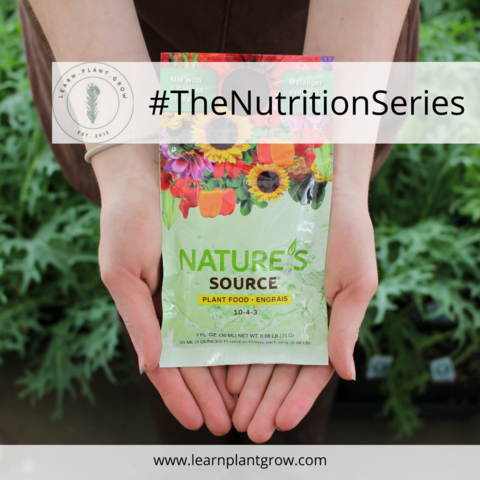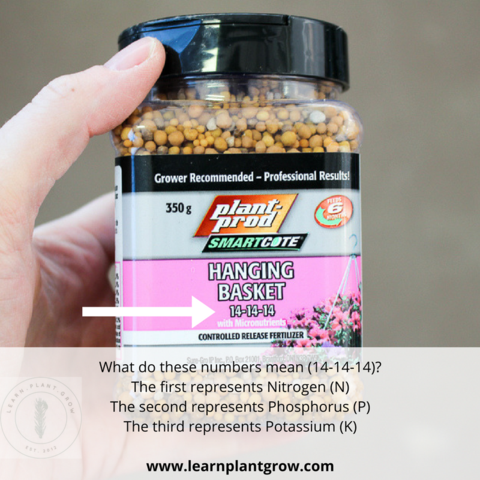This post was co-authored by my awesome husband Tanner Pollack. Tanner’s background is agronomy (the science of growing crops) with a focus on crop production. He runs an agronomy consulting business and farms in Northern Alberta.
In our last blog, we looked at the macronutrients that are abundant all around us – carbon, oxygen, and hydrogen. These are the “freebies” when it comes to growing plants (carbon dioxide and oxygen from air, and oxygen and hydrogen from water). In Part 3 of #TheNutritionSeries, we’re going to look at the “Big 3” when it comes to plant nutrition – nitrogen, phosphorous, and potassium (otherwise known as the primary macronutrients).

#TheNutritionSeries Part 3: “The Big 3”
Nitrogen
What’s the first thing you think of when I say Nitrogen (N)? The first thing we think of is air! It’s all around us – it makes up about 79-80% of the air we breathe (crazy, right?). However, it’s in a secret cloak, it’s in its unavailable form N2 (nitrogen gas). N is a very important plant nutrient because most of the time there just isn’t enough of it in plant-available forms in nature. Not having enough N results in plants that are pale (called chlorosis) and stunted, with the old leaves more pale than the new leaves. Nitrogen’s primary use in plants (and us) is amino acid synthesis; these amino acids are the building blocks of enzymes and proteins that keep us alive.
So how do we make N available for plants? Plants can’t actually do this on their own, but it turns out nature came up with some really cool solutions. Certain plants, called legumes (like your garden peas), have formed a symbiotic (friendly) relationship with bacteria. These bacteria, called rhizobia, infect root hairs in the plant and form nodules. Within these nodules the rhizobia “fix” atmospheric N into ammonia (NH3) which is quickly converted into ammonium (NH4+) and then nitrate (NO3-) – forms of N that the plant can use. (Whoo hoo!!) In exchange for nitrogen fixing, the plant provides the rhizobia with sugars so it can survive. Pretty cool, right? N is also “fixed” into plant available forms on a smaller scale by lightning, and by other free-living bacteria in the soil. Decomposition of soil organic matter is another important N source.
A Little Nitrogen History
People have been using different fertilizers to add N to the soil for over 2000 years, (and probably longer). Manure from farm animals and guano (from bats and seabirds) have been important fertilizer sources. There are also natural nitrate deposits scattered around the world (sodium nitrate or potassium nitrate) that have been mined for years. However, what was needed was a source of nitrogen that was cheaper and more reliable. In the early 1900’s, a German scientist. Fritz Haber, developed the process; it was then commercialized by another German scientist, Carl Bosch. The Haber-Bosch process (as it is now known) uses atmospheric N (N2, that hard to use molecule) and hydrogen, with heat, pressure, and a metal catalyst, to produce ammonia (NH3, the same product as nitrogen fixation in legumes). This process has become so important to humanity, that current estimates peg 80% of the nitrogen in our bodies as being derived from the Haber process. (Tanner “I find this subject personally very interesting; if you are at all interested in the good history, people, politics, and driving forces behind humanity’s efforts gain control of our nitrogen supply, I recommend The Alchemy of Air by Thomas Hager.”)
Phosphorous
Next up is Phosphorous (P), which is used for many different functions in the plant. P is used as a structural component of DNA and cell membranes; it’s also important for energy transfer in the plant. P tends to concentrate at growing points in plants; it helps promote new growth, such as roots and flowers. Readily available P in the soil also helps with plant vigor (especially in cold soils) and can help plants tolerate frost a little bit better.
In the soil, P is a bit trickier than N. It tends to be bound up quickly by aluminum and iron at a low pH (<5.5), or by calcium at a high pH (>7.8). This is one of the reasons we encourage gardeners to take a soil test if they are having issues in their gardens; it allows us to identify soil characteristics (organic matter, pH, texture) as well as the background levels of Nitrogen, Phosphorus, and Potassium and other plant nutrients.
Back to P – plants that are short on P can show a lot of the same symptoms as N deficiency. Stunted growth, chlorosis of older leaves, and dull color are a few of the symptoms. Purpling of older leaves (on plants that aren’t supposed to be purple!) is also a symptom of plants lacking P. Luckily, plants can respond quickly when a high P fertilizer is added. There are many good sources of P fertilizer available. Manure and compost are great sources of phosphorous, and can be used to build soil levels in your garden. I tend to prefer compost over raw manure for gardens, as the composting process destroys weed seeds and ensures everything is thoroughly mixed, resulting in a more uniform product. Bone meal is another great P source (bones are made up of calcium AND phosphorous), especially for spot treatments (think transplanting trees, baskets, and pots). They’re also great commercial fertilizers available; 11-52-0 is the highest P containing fertilizer available. Commercial fertilizers are great because they’re uniform; they can be easily and uniformly applied with small spin spreaders. You might be asking – wouldn’t a “natural” fertilizer be better than a “synthetic” fertilizer? I’ll let you in on a secret – the plants don’t care! Their roots are looking for the nutrients needed, and once they are in the soil there is no difference to the nutrients that are provided. The commercially available fertilizers tend to be more concentrated than natural sources, so we often see them over-applied in gardens, which throws other nutrients out of balance.
A quick note on applying phosphorous fertilizers: P is VERY immobile in the soil; that is, it stays where it is placed. Dry P fertilizers (compost, bonemeal, 11-52-0, etc.) are best applied in the spring or fall before you work your garden. Incorporating P in this manner helps distribute it in the soil, giving the plant roots the best chance of finding it. Fertilizers that are applied with water (such as Nature’s Source ®) are typically lower in concentration, but are a better fit for use in-season.
Potassium
Potassium (K) goes back a long time. K stands for kalium, the Latin term for potassium. Humans have been adding potassium as a fertilizer for a long time; the earliest forms were ash from cooking and heating fires – this is the origin of the term potash, which we now use to describe our K fertilizer. Manure and compost are also great K fertilizer sources for garden use.
Potassium is really important to our plants, and our plants often need more of it than nitrogen! But where N and P are harder to find in the natural environment, we can usually find lots of K. Some soils may be naturally low (sand), or hold onto potassium very tightly (heavy clays), which can create some issues for gardens. Again, looking at a soil test will provide some information on soil K levels, and asking for a soil texture analysis can help fill in the picture on K.
Potassium is unique in plants, especially when compared to N and P. Where N and P really get used in building plant structures, K is more of a mover and shaker. K helps to transport other minerals up from the roots to the shoots (through the xylem) and move sugars from the leaves to the growing points. Plants that have good K supply throughout the growing season will produce bigger, sweeter veggies than those that do not. K also aids in cellulose formation, the “glue” between cells that helps make them stronger. Plants that are low in K may fall over (we call it lodging in farming) from wind or rain, and be less likely to stand back up after getting lodged.
How This Applies To You

Sources:
Marschner, Horst. Mineral Nutrition of Higher Plants, second edition. Academic Press, 1995.
Comments +